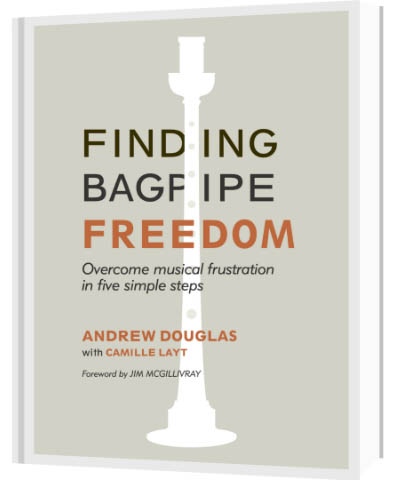‘Rhythm – the foundation of creative freedom’ – an exclusive excerpt from ‘Finding Bagpipe Freedom’
 Finding Bagpipe Freedom is a new self-help book for pipers by Andrew Douglas. The book is available for US$29.99 starting on July 4th.
Finding Bagpipe Freedom is a new self-help book for pipers by Andrew Douglas. The book is available for US$29.99 starting on July 4th.
“This book is targeted primarily at intermediate pipers who are ‘stuck,’ and encourages readers to re-think their approach to the music via the methodology we’ve developed at the Piper’s Dojo over the last 10 years,” Douglas said.
Here’s the first of a few exclusive excerpts, chosen by Douglas, that we’ll publish to give you a taste of the 245-page Finding Bagpipe Freedom.
Rhythm – the foundation of creative freedom
Sometimes, pipers get so overwhelmed trying to figure out 16th notes, dots, cuts, triplets, and time signatures, that they fail to see the forest for the trees – many sort of shut down, give up trying, and . . . you know . . . just go to expression workshops with famous pipers instead of tending to their foundation.
But here’s the rub. If you never fully learn to understand the basic “language” of rhythm, you can never do more than mimic other music. You can listen to pipe tunes over and over again, and teach yourself the rough sequence and timing of notes that will be required, and regurgitate a “paint-by-numbers” tune or two. For a while it will seem that you’ve beaten the system, and that you don’t need any of that rhythm mumbo-jumbo to be a happy piper.
But inevitably this illusion will start to crumble. You’ll want to join a band that challenges you. They’ll hand music to you, but there won’t be any reference recordings available. With no way to monkey-see-monkey-do the learning of the tunes, you’ll have to give up on the notion that you can play in a higher level band.
Then one day, a beautiful phrase will pop into your head, and you’ll feel inspired to turn it into a tune. But, even though you know the notes that the tune should have, you have no idea how to write it out, or even how to figure out if it’s a jig or a reel or a march or a strathspey. Guess you better give up on being a composer, too.
Later, your guitar-playing cousin will invite you to jam with him. After realizing you can’t play in time with him (“Sorry, it’s too different from how I usually play it.”), the jam session will just turn into a beer or two, and you’ll have to give up on the idea of jamming out with other instruments, too.
Only by understanding rhythm, and learning to control it, can we truly set ourselves on a path to be creatively free with our instrument.
Solo competition is next – now this, this is right up your alley! But, after being told by your judges, and instructors, and famous pipers at workshops that your tempo is just crazy out of control, and that all of your embellishments are coming in ahead of the beat – you’re either going to have to dig deep on rhythmic development, or give up on this, too.
Can you see how mimicry is not a sustainable long-term strategy?
Only by understanding rhythm, and learning to control it, can we truly set ourselves on a path to be creatively free with our instrument.
Even if you’re not interested in playing with a guitarist or solo competing at this stage in your development, you might be some day. Or, you might find that you’re eventually fascinated by something completely different that you don’t even know about yet.
To be prepared to explore any cool opportunity when it arises, you need to build a foundation that will allow for flexibility throughout your piping career. Otherwise, you’re just digging a creativity grave, sucking all potential enjoyment out of something that should have infinite potential to inspire you for a lifetime.
Stay tuned for more excerpts from Finding Bagpipe Freedom in the coming days.
Related
![]() ‘Finding Bagpipe Freedom’ by Andrew Douglas aims to help stuck pipers
‘Finding Bagpipe Freedom’ by Andrew Douglas aims to help stuck pipers
June 13, 2021

NO COMMENTS YET